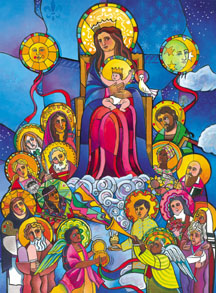Post-Ascension Church and Mary
Mary and the Time of the Church
Post-Ascension Church and Mary
– Father Johann Roten S.M.
The French writer, Henry Bordeaux, in welcoming Henri Bremond, the author of a famous history of French spirituality, to the French Academy, noted pointedly in his welcoming address: "Your great mystical fresco is a series of pieces placed side by side. An exacting critic would desire a more clearly defined play and better established proportions, though to offset this he might add that when a great procession passes by you do not spend your time counting the buttons on the coats."
To count the buttons on the coat of this Gospel would mean to speak about unclean spirits, all kinds of diseases, lost sheep, various charisms and/or the different personality profiles of the twelve apostles.
But, necessary though buttons may be, let us rather turn our attention to the procession, the central object of the Gospel -- that is, to the kingdom of heaven, alias the time of the Church.

Matthew, in this part of the ecclesial portion of his Gospel, reminds us and anticipates the time of the Church, the time when Jesus Christ no longer walks with his disciples, the time when alone and together they have to learn how to be Church--with the Holy Spirit dwelling in the depth of their souls. It is the time when the struggle for the total Christ (Christus totus) begins, understood very often in Church history either as a continual retrieval of the pristine purity of his message or the relentless battle and conquest of new horizons for God's kingdom.
The Church's time coincides with the history of all the legitimate traditions to read, search and implement the very own words and deeds of Christ; legitimate traditions that go with tension, opposition, occasional ruptures and the continuous need for reconciliation. Let me mention only the most sacred and preeminent among them: 1) the tradition of James or the need for law, history and culture, the becoming of the Church in given space and at set time; 2) or take the tradition of Paul: the Church built upon individual vocation and personal commitment, Church as expression of freedom in grace and constant renewal in the Spirit; 3) and then, there is Peter and his tradition: the gubernatorial Church, the structures to identify the masses, the institution to assure visible presence and the organization to prevent generosity and care from tiring out too soon; 4) yet, there is no life without love, there is no Church tradition without the tradition of John, which is to remain in Christ's love, remain and perdure with and against the world, remain and perdure in the narrow space between passion and resurrection.
Dear Brothers and Sisters, you may have recognized in these traditions the four major traits of Christ's god-human and eternal face: that of the historical Christ (James), that of the Christ of faith (Paul), the ever present eschatological Christ (John) and the ethical Christ (Peter) to challenge the practical commitment of his followers.
All these traditions complement each other, they deepen and enrich one another; because they are grounded in an even more fundamental tradition, the Marian tradition. Mary is the primitive cell of the Church, on which the incarnate Word can be imprinted without resistance. She is the encompassing motherliness of the Church within which truth no longer disunites and charity no longer segregates. In all this she is blessed because her existence is filled with hearing the word of God and keeping it, thereby establishing the very ground rules of all and any Church tradition.
And it is because of Mary that Christ the Lord and bridegroom makes this pledge to the Church of Peter and Paul, but also to that of all the baptized Joneses, Gonzalezes, Duponts and Meyers of salvation history:
My kingdom is invisible, but I want to establish you, my Bride, before the eyes of men so visibly that no one will be able to overlook you. I want to raise you up like the brazen serpent in the desert.... I want to establish you upon iron foundations, and your structure is to be a true and distinctive sign that I am setting up, a memorial to myself upon the earth. You will be my witness to the very edge of the world, a witness that I was in the world, and I will not forsake you until the end of time. (Balthasar, Heart of the World)
My Brothers and Sisters, whether that Church stands in Nero's garden on the Vatican Hill, at Archangelsk or Abidjan is not important. It only shows that we have to live on earth without possessing a real home, that the Church is a widely known but little loved sign. What really matters, dear Brothers, is that the Church will always remain the captive of God's crucified love--and each one of us the happy prisoner of God's possessive tenderness for us. Amen.
All About Mary includes a variety of content, much of which reflects the expertise, interpretations and opinions of the individual authors and not necessarily of the Marian Library or the University of Dayton. Please share feedback or suggestions with marianlibrary@udayton.edu.
